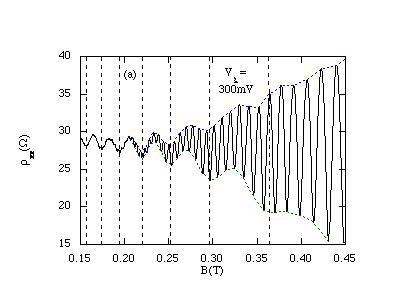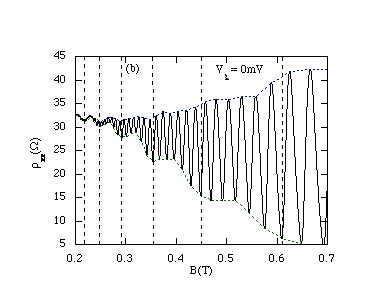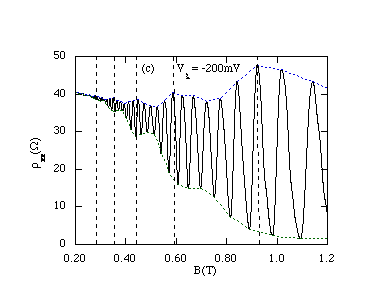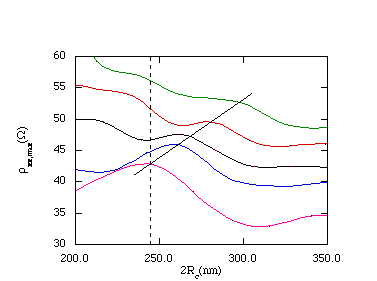
Fig. 1:
T. Schlösser, K. Ensslin, and J. P. Kotthaus
Sektion Physik, LMU München, D-80539 München, Germany
M. Holland
Dept. of Electronics, University of Glasgow, United Kingdom
A laterally modulated gate electrode is evaporated on high-mobility two dimensional electron systems embedded in GaAs-AlGaAs heterostructures. At small lateral potential modulation of square geometry as induced by a suitable gate voltage commensurability oscillations dominate the low-field magnetoresistance indicating the oscillating width of the Landau bands. For increasing potential modulation the width of the Landau bands increases, the band contributions to the conductivity are suppressed and scattering conductivity dominates reflecting our beginning to resolve the internal structure of a Landau band.
person to whom correspondence should be addressed:
Klaus Ensslin
Sektion Physik der Universität München, Geschwister-Scholl-Platz 1, D-80539 München, Germany
Phone: +49-89-210-3732
Fax: +49-89-2180-3182
email: klaus.ensslin@physik.uni-muenchen.de
Introduction
In a magnetic field the energy spectrum of a homogeneous two-dimensional electron gas (2DEG) splits up into Landau levels whose width is determined by the single particle life time of the carriers. If a laterally periodic potential modulation is superimposed onto the 2DEG the Landau levels transform into Landau bands [1] that are theoretically expected to have a rich internal energy spectrum in the two-dimensional case [2]. At low magnetic fields commensurability oscillations have been observed in the magnetoresistance [3]. Landau bands generally oscillate as a function of center coordinate leading to a finite group velocity and therefore to a band contribution to the conductivity. At flat band condition the Landau band width vanishes explaining the observed minima in the conductivity. To the best of our knowledge there is no convincing experiment so far that unambiguously demonstrates additional subbands and gaps within one Landau band. [2] In this paper we present experimental data that clearly exhibits suppression of band conductivity for increasing potential modulation. We argue that this is caused by our beginning to resolve the internal structure of the Landau bands eventually leading to additional substructure superimposed on the maxima of the Shubnikov-de Haas oscillations.
Small Potential Modulation
The AlGaAs/GaAs heterojunctions containing a 2DEG only 36 nm below the surface were grown by molecular beam epitaxy. At liquid He temperatures the 2DEG has a mobility u = 400 000 cm2/Vs and a carrier density Ns = 5x1011 cm-2, corresponding to a mean free path of l = 4.7 um and a Fermi wavelength of [[lambda]]F = 35 nm. A Hall bar geometry is defined by wet chemical etching with an area of 20 um x 8 um between the voltage probes, i.e. dimensions that are larger than the elastic and inelastic mean free path. With electron beam lithography a resist layer on the sample surface is suitably exposed and developed to create a lattice of voids and then covered by an evaporated gate metal. Since the 2DEG is so close to the sample surface this gives us the unique possibility to induce lateral superlattices with periods as small as 80 nm and relatively large potential modulation.
We study square superlattice devices with periods a of 205 nm, 139 nm, 105 nm and 80 nm. In the following we will concentrate on the sample with a =139 nm because there the compromise between small lattice periods and moderate potential modulation is best achieved and the observed effects are most pronounced. However, the main features are also observed on the other short period samples.
With low current levels (<= 10 nA) we measure the magnetoresistance of the samples immersed in the mixing chamber of a dilution refrigerator at a bath temperature of 30 mK as exemplified in Fig. 1 (a). For low magnetic fields commensurability oscillations occur that are superimposed by SdH oscillations. The vertical dashed lines indicate the condition where the Landau bands are flat [1]. In this case the Landau bands have no dispersion leading to a vanishing band conductivity and therefore to a minimum in the resistance. The amplitude of the Shubnikov-de Haas (SdH) oscillations generally increases with magnetic field B (see envelopes). It is obvious from Fig. 1 (a), however, that the SdH amplitudes are especially large in the minima of the lower envelope, i.e. at flat band. Scattering contributions to the conductivity essentially resemble the density of states. For flat Landau bands the gaps between the Landau bands widen and one expects large contributions of the scattering conductivity. The amplitude of the SdH oscillations is thus a qualitative measure for the Landau gap and therefore for the width of the Landau bands. We like to mention here that we can detect well defined commensurability oscillations down to magnetic fields of 0.1 T corresponding to a classical cyclotron diameter as large as 12 lattice periods. This indicates the homogeneity of our sample as well as of the fabrication process.
Medium Potential Modulation
Figure 1 (b) displays experimental results for the magnetoresistance for Vg=0 which leads to a larger potential modulation. The envelopes of the SdH oscillations are indicated by dashed lines. The positions of the minima of the lower envelope experimentally defines flat band condition for all three cases of potential modulation (Fig. 1 (a)-(c)) in excellent agreement with the theoretical prediction (vertical dashed lines) [1].The envelope connecting the maxima shows minima at flat band for low magnetic fields going over to maxima at high magnetic fields. This is an indication that the importance of scattering conductivity increases with increasing magnetic field [1,4].
In comparing the results presented in Fig. 1 (a) and (b) it is obvious that the contributions of scattering conductivity to the total conductivity increases for increasing potential modulation as the amplitude of the SdH oscillations becomes especially large at flat band.
Strong Potential Modulation
At Vg = -200 mV (see Fig.1 (c)) band conductivity is completely suppressed and the maxima of the upper envelope of the SdH oscillations clearly lie at flat band condition as marked by the vertical dashed lines. The features of the upper envelope, however, show a continuous transition from minima to maxima at flat band. We argue that the suppression of band conductivity is caused by the beginning resolution of the internal structure of the Landau bands. [1]
In order to illustrate this effect more clearly Fig. 2 shows only the envelopes of the SdH maxima plotted as a function of classical cyclotron diameter covering typically two lattice constants in this regime. For strong potential modulation (lowest curve) a maximum is observed at flat band (vertical dashed line) indicating the dominance of scattering conductivity. For decreasing potential modulation the maximum shifts to larger values of 2Rc as indicated by the solid line finally leaving a minimum close to the flat band condition which resembles the band conductivity contributions.
In general band conductivity as well as scattering conductivity contribute to the commensurability oscillations. The extreme cases however, clearly show that for weak potential modulation band conductivity dominates (Fig. 1(a)) and for strong potential modulation scattering conductivity (Fig. 1(c)) takes over.
It is important to note that the suppression of band conductivity is observed for increasing potential modulation in contrast to Ref. [4] where band conductivity was detected to vanish for increasing mobility and decreasing potential modulation. In our case the mobility as deduced from the zero field resistance hardly changes in our set of data as presented in Fig.1(a)-(c). The collision broadening of minibands within a Landau band should therefore hardly change in the regime of interest. We argue that the likelihood for the resolution of the internal structure of a Landau band improves for increasing band width which generally increases with increasing potential modulation.
We like to mention that we observe additional structure superimposed on the maxima of the SdH oscillations for very strong potential modulation close to the antidot regime. Silberbauer and Rössler [6] showed that the energy spectrum of a realistic antidot potential is very complicated and that the Landau bands may strongly overlap and mix. It is not clear in our sample how the exact potential looks like and it is difficult to predict how the coupling of the Landau bands [7] might influence the various subbands and gaps. Electron-electron interactions may further complicate the experimentally detectable bandstructure. The fact, however, that 1/B periodic SdH oscillations can be resolved in the experiment indicates that the terminology of Landau bands is basically still valid.
Conclusions
The magnetic field dependent width of Landau bands in a lateral superlattice leads to pronounced oscillations in the magnetoresistance of such systems. Our experiments demonstrate the breakdown of bandconductivity for increasing potential modulation indicating our beginning to resolve the internal structure of a Landau band.
We are grateful to the Deutsche Forschungsgemeinschaft and the ESPRIT Basic Research Action for financial support.
References
[1] D. Pfannkuche and R. R. Gerhardts, Phys. Rev. B46, 12606 (1992)
[2] D. Langbein, Phys. Rev. 180, 633 (1969), D. R. Hofstadter, Phys. Rev. B14, 2239 (1976)
[3] D. Weiss, K. v. Klitzing, K. Ploog, and G. Weimann, Europhys. Lett. 8, 179 (1989), R. W. Winkler, J. P. Kotthaus, and K. Ploog, Phys. Rev. Lett. 62, 1177 (1989), E. S. Alves, P. H. Beton, M. Henini, L. Eaves, P. C. Main, O. H. Hughes, G. A. Toombs, S. P. Beaumont, C. D. W. Wilkinson, J. Phys. C1, 8257 (1989)
[4] D. Weiss, A. Menschig, K. v. Klitzing, and G. Weimann, Surf. Sci. 263, 314 (1992)
[5] for a review see R. Schuster and K. Ensslin, Advances in Solid State State Physics 34, 195 (1994), Springer, Berlin
[6] H. Silberbauer and U. Rössler, Phys. Rev. B50, 11911 (1994)
[7] G. Petschel and T. Geisel, Phys. Rev. Lett. 71, 239 (1993)

Fig. 1:
(a) Magnetoresistance for a weakly modulated electron gas. The vertical dashed lines indicate magnetic field positions where the Landau bands are flat. At those values the experiment reveals minima in the resistance modulation and especially pronounced SdH oscillations as visualized by the envelope of the minima and maxima of the SdH oscillations.

(b) Magnetoresistance for a moderately modulated electron gas. For increasing
magnetic fields the contribution of scattering conductivity leads to maxima of
the upper envelope of the SdH oscillations at flat band condition.

(c) Magnetoresistance in the regime of strong potential modulation where the
Landau bands are relatively wide. The upper envelope of the SdH oscillations
clearly shows maxima at flat band indicating the breakdown of band
conductivity.

Fig. 2: Envelope of the SdH maxima as a function of classical cyclotron
diameter for various values of the potential modulation as tuned by a gate
voltage (from lowest trace Vg=-200mV to uppermost trace Vg=+200mV with
[[Delta]]Vg=100mV).